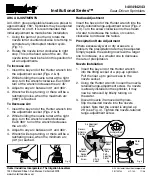
SECTION
1:
DESCRIPTION AND SPECIFICATIONS
1.1 DESCRIPTION
(See!
Block Diagram,
Figure
1-1)
The Model
is
a System
to
System Adapter (or inter-
face). It interconnects the voice signals between different
intercom systems.
In
addition,
it
can
optionally
“Calls”
or
signals between systems. Each
in-
cludes two two-wire
to
four-wire converters. The four-wire
interface can deliver
and
accept
high
level signals such
as
those
from
the
intercom
system.
An
can
also function
as
a two-wire
to
by
necting the two individual interfaces at the
four-wire
level.
The
two voice channels when
used as
a dual
two-wire
to four-wire interface, and one voice channel when
functioning
as
a two-wire to two-wire interface.
A
front panel channel select switch for each
of
the two
interfaces (A and
B)
will select one of two, two-wire chan-
nels. For
use,
the switch will be in the Channel
2
position. For
Audiocom
use, a rear panel switch will select
balanced two-wire operation.
Front panel controls include
1)
adjustments for null, level,
ducking,
2)
switches for monitoring and channel select.
Rear
panel controls include
switches for
the two-wire
of each interface.
Rear
panel con-
nectors include two
connectors for two-wire, eight
for two
one
connector for duplicate four-wire connections plus options
connections. The terminals
are
useful
for rapid field connec-
tions. The
D
connector
aids rapid replacement where mean-
time-to-repair
is
an issue and
also
allows option strapping.
The
replaces the Model
and
inter-
faces where powering
from the
is not
required.
Differences between the Model
interface
and Model
include
the
following:
1)
The
is
self
(locally) powered, the
is usually
powered
from
the
line or may
be
locally
powered.
2)
The
has
a maximum output at
the
four-wire output port
of
+22
the
maximum output is
9
1.2 SPECIFICATIONS
FUNCTIONAL
The Model
consists of two two-wire
to
four-wire
converters in a single package (converter A and converter
B).
If
the
two converters
are
interconnected, the Model
then functions
as
two-wire
to
two-wire converter. The
method
of
interconnection is
as
follows: converter A’s four-
output
connected
to
converter
four-wire input;
converter A’s four-wire input
is
connected
to
converter
B’s
output.
Converter
two-wire port is driven by an active balanced
bilateral current
source
(an
optional transformer may be
added). Converter
B’s
two-wire
port
is
similar to Converter
A’S.
Converter
A’s four-wire output
port
is
driven by an active
balanced voltage line driver (or
via
an optional transformer).
A
build-out resistor (about 33
ohms)
in each
leg
of the
differential output maintains stability driving long cables.
Converter
B’s
four-wire output port
is
similar
to
converter
A’S.
The optional
can be
used
to
provide higher
common
mode voltage isolation between the four-wire sys-
and
the
two-wire systems.
Converter A’s four-wire input
port
is active balanced, bridg-
ing, ten thousand ohms impedance. Converter
B’s
four-wire
input port
is
similar
to
converter
A‘s.
(An
optional
trans-
former
is
available for the four-wire
Adjustable,
0
to
30
dB.
Toggles
from
one
direction to the
other (threshold
is
factory
set).
There
is
one
adjustment for
interface
A
and one for interface
B.
Each interface has depth
level adjustment (front panel).
Uses
standard headset. Front Panel has six pin female
type
headset connector.
Switch on front panel activates the monitoring function.
User
uses
headset microphone
or
a built
in oscillator
to
adjust for
null in headset earphones (or via
a
built-in oscillator which
is
jumper selected by a
on the printed circuit board).
There
are
three
null adjustments
associated
with each
two-
wire
port.
These
are
resistive (medium), capacitive (high),
and inductive (low) nulls. Medium, High, and Low refers
to
frequency
ranges;
medium centers about
1
kilohertz, high, 3
kilohertz,
low, 300 hertz.
There
are
two level adjustments for interface
A
(to-from
two-wire) and two for interface
B
(to-from two-wire).
User
Manual






























